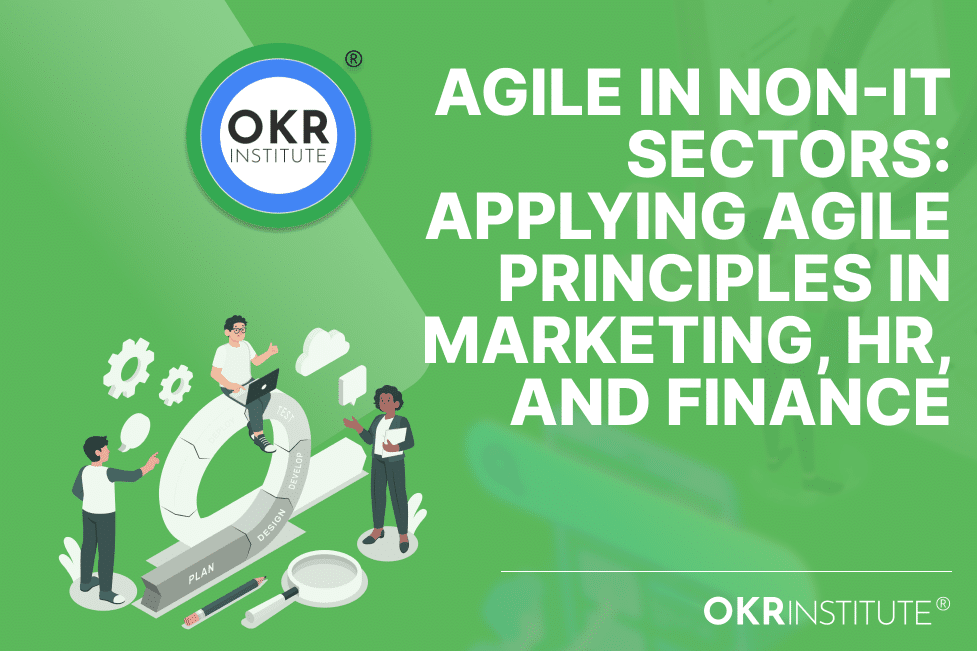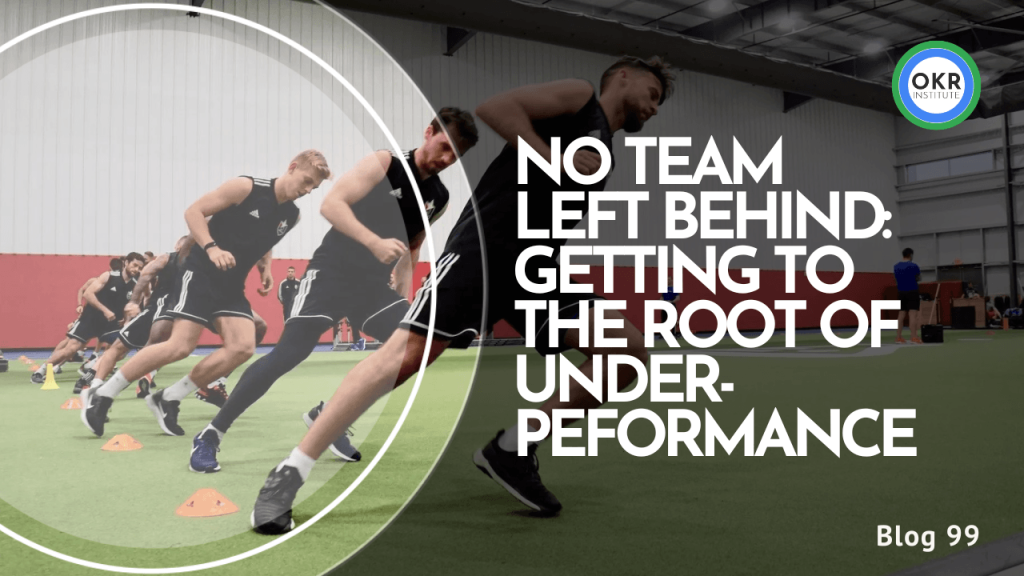Agile in Non-IT Sectors: Applying Agile Principles in Marketing, HR, and Finance

Introduction
In recent years, Agile methodologies have transcended their origins in software development to become a game-changer across various sectors. From marketing to human resources (HR) and finance, the principles of Agile—flexibility, collaboration, and continuous improvement—are driving significant improvements in efficiency, innovation, and employee engagement. This blog explores how Agile can be successfully applied in non-IT sectors and how combining Agile with OKR (Objectives and Key Results) leadership can further enhance organizational performance.
What is Agile?
Agile is a project management and product development approach that emphasizes iterative progress, collaboration, and adaptability. Originally developed for software development, Agile focuses on delivering small, incremental changes to a product or project, allowing teams to respond quickly to feedback and changing requirements. Key Agile principles include:
- Customer Collaboration: Engaging with customers to understand their needs and receive feedback.
- Adaptive Planning: Continuously updating plans based on new insights and changes.
- Early and Continuous Delivery: Delivering small, functional pieces of work frequently.
- Cross-Functional Teams: Encouraging teams with diverse skills to work together seamlessly.
Applying Agile in Marketing
1. Agile Marketing Frameworks
Agile marketing frameworks, such as Scrum and Kanban, can help marketing teams manage their projects more efficiently. By breaking down large campaigns into smaller, manageable tasks, teams can deliver marketing materials more quickly and adapt to changes in market conditions.
Scrum: In Scrum, marketing teams work in short, time-boxed sprints, typically lasting two to four weeks. Each sprint begins with a planning meeting where the team selects tasks from a prioritized backlog. Daily stand-up meetings keep the team aligned and focused on their goals. At the end of each sprint, a review meeting evaluates the work completed, followed by a retrospective to discuss improvements for the next sprint.
Kanban: Kanban focuses on visualizing the flow of work and limiting work in progress. Marketing tasks are displayed on a Kanban board, categorized by their current status (e.g., To Do, In Progress, Done). This approach helps teams identify bottlenecks and streamline their processes for better efficiency.
2. Benefits of Agile Marketing
- Increased Flexibility: Agile marketing allows teams to respond quickly to market changes and customer feedback.
- Improved Collaboration: Cross-functional teams work closely together, enhancing communication and reducing silos.
- Higher Productivity: By focusing on smaller tasks, teams can deliver more work in less time.
- Better Alignment with Business Goals: Agile marketing ensures that all activities are aligned with broader business objectives.
Applying Agile in HR
1. Agile HR Practices
Agile principles can also be applied to human resources to create a more adaptive and responsive HR function. Agile HR focuses on improving employee engagement, performance management, and recruitment processes.
Performance Management: Traditional annual performance reviews can be replaced with continuous feedback and regular check-ins. This approach helps employees stay aligned with their goals and receive timely guidance.
Recruitment: Agile recruitment involves iterative hiring processes, where candidates are assessed and onboarded in smaller batches. This method allows HR teams to fill positions more quickly and adapt their hiring strategies based on ongoing feedback.
Employee Development: Agile HR emphasizes continuous learning and development. Regular training sessions, workshops, and mentorship programs help employees build new skills and stay motivated.
2. Benefits of Agile HR
- Enhanced Employee Engagement: Continuous feedback and development opportunities increase employee satisfaction and retention.
- Faster Recruitment: Iterative hiring processes reduce time-to-hire and improve candidate experience.
- Improved Performance Management: Regular check-ins provide timely feedback, helping employees stay on track with their goals.
- Greater Adaptability: Agile HR can quickly respond to organizational changes and evolving employee needs.
Applying Agile in Finance
1. Agile Finance Practices
Agile methodologies can transform financial management by increasing transparency, improving collaboration, and enabling faster decision-making.
Financial Planning and Analysis (FP&A): Agile FP&A involves iterative budgeting and forecasting processes. Instead of annual budgets, finance teams create rolling forecasts that are updated regularly based on actual performance and changing market conditions.
Project Management: Agile project management techniques, such as Scrum and Kanban, can be applied to financial projects to improve efficiency and delivery times. Finance teams can break down large projects into smaller tasks, prioritize them, and track their progress on a visual board.
Compliance and Risk Management: Agile principles can help finance teams manage compliance and risk more effectively. By conducting regular audits and reviews, teams can identify and address issues early, reducing the likelihood of major compliance failures.
2. Benefits of Agile Finance
- Increased Transparency: Agile practices provide greater visibility into financial processes and performance.
- Better Collaboration: Cross-functional teams work together to achieve financial goals, improving communication and reducing silos.
- Faster Decision-Making: Iterative planning and continuous feedback enable quicker and more informed decisions.
- Improved Risk Management: Regular reviews and audits help finance teams identify and mitigate risks proactively.
Combining Agile with OKR Leadership
1. Understanding OKRs
OKRs (Objectives and Key Results) are a goal-setting framework that helps organizations define and achieve their objectives. Objectives are the high-level goals that teams aim to achieve, while Key Results are the specific, measurable outcomes that indicate progress toward those goals.
2. Benefits of Combining Agile and OKRs
Combining Agile methodologies with OKR leadership can amplify the benefits of both approaches, driving higher performance and alignment across the organization.
Clear Goals and Priorities: OKRs provide a clear framework for setting and prioritizing goals. Agile methodologies ensure that teams can adapt their plans and activities to achieve these goals effectively.
Improved Focus and Accountability: OKRs help teams stay focused on their most important objectives. Agile practices, such as regular check-ins and retrospectives, ensure that teams are accountable for their progress and continuously improving.
Enhanced Collaboration: Both Agile and OKRs emphasize collaboration and cross-functional teamwork. By integrating these approaches, organizations can foster a culture of collaboration and shared responsibility.
Continuous Improvement: Agile methodologies and OKRs both promote continuous improvement. Regular reviews and feedback loops help teams identify areas for improvement and make necessary adjustments.
Conclusion
Agile principles are no longer confined to the realm of software development. By applying Agile methodologies in marketing, HR, and finance, organizations can achieve greater flexibility, collaboration, and efficiency. Combining Agile with OKR leadership further enhances these benefits, driving performance and innovation across the organization. As more sectors adopt Agile practices, the potential for transformation and growth is limitless.
CEO of the OKR Institute
Related Courses
Recent Posts
Tags
#OKR
#OKR Coaching
#OKR Coach







